7 Mistakes That Are Killing Your Email Conversions
If you run an online business, you probably have an email list.
If your emails aren’t getting any conversions, you might be making some of these conversion-killing mistakes.
These mistakes will not only result in a low conversion rate but will also lead to people unsubscribing from your email list.
In this article, I will share the common email marketing mistakes most online businesses make and how to avoid them.
Not Sending a Welcome Email
If you don’t have an automated welcome email for your email list, you’re missing out on building a relationship with your subscribers.
And if you don’t have a relationship with them, how will you sell them anything?
Your welcome email is your opportunity to build a relationship with your new subscribers by offering some value upfront.
Rather than sending an email to say hi, why not email your subscribers your best tips in your welcome email? Or links to your best content.
If you can hook your subscriber in the first email, you’ll have them for life…
Your welcome email also gives you the opportunity to differentiate yourself from every other company in your niche.
Brennan Dunn of Double Your Freelancing uses this opportunity well:
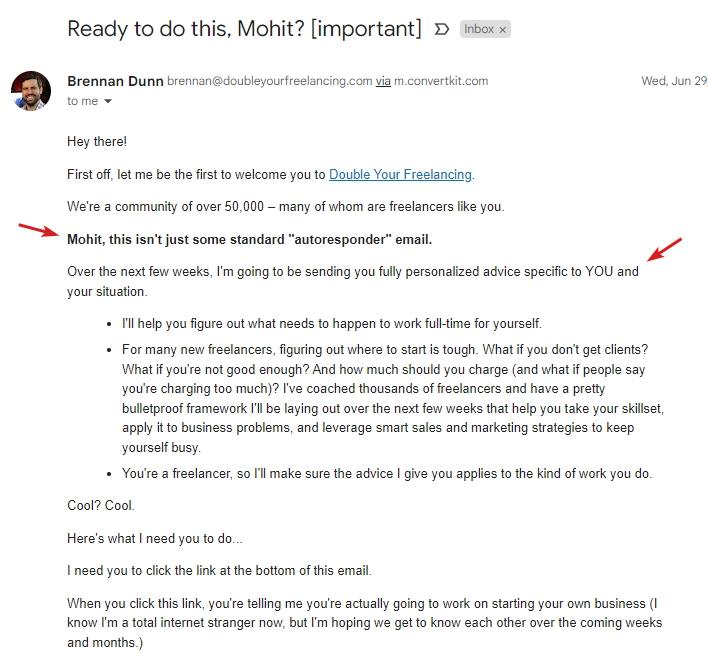
Notice how he talks about how his emails differ from everyone else you’ve previously subscribed to. His emails will contain advice tailored to you, a freelancer.
Many people who subscribe to your email list will read your welcome email because they’ll see a notification for the email on their phone as soon as they subscribe. So don’t waste this opportunity.
Not Emailing Regularly
If you’re only sending emails every couple of months, your subscribers will quickly forget about you.
Most businesses’ biggest fear is that they will send too many emails and bum out their subscribers.
But the fact is that most of your subscribers will never see your emails. That’s the sad truth of email marketing…
If you send ten emails, most of your subscribers will only see maybe five emails.
Maybe they noticed your email but had to take their dog for a walk. Maybe they scrolled past your subject line to an email from their boss. Whatever the reason, most of your subscribers will never see most of your emails.
The more emails you send, the better.
But you can’t just pester your subscribers with low-value emails.
If you don’t have any original content of your own, you can always start a weekly newsletter. It only takes 52 emails a year. And all you have to do is create a round-up of the best articles in your industry. In return, you get to promote your products from time to time.
Sending Emails That Are All Over The Place
Every email you send your subscribers has to have a purpose.
As a general rule, one email should only have one purpose.
Most businesses send emails that are all over the place. They ask you to read their latest blog post, check out their latest offer, sign up for their webinar, and subscribe to their YouTube channel — all in one email.
Humans don’t like choices. The more options you give someone, the less likely they are to choose. Make your subscriber’s life easy: Have a clear call to action in every email.
Do you have a new offer for your product? Then your email should be all about why your subscribers should buy.
Here’s a great example of this from Chris Ducker:
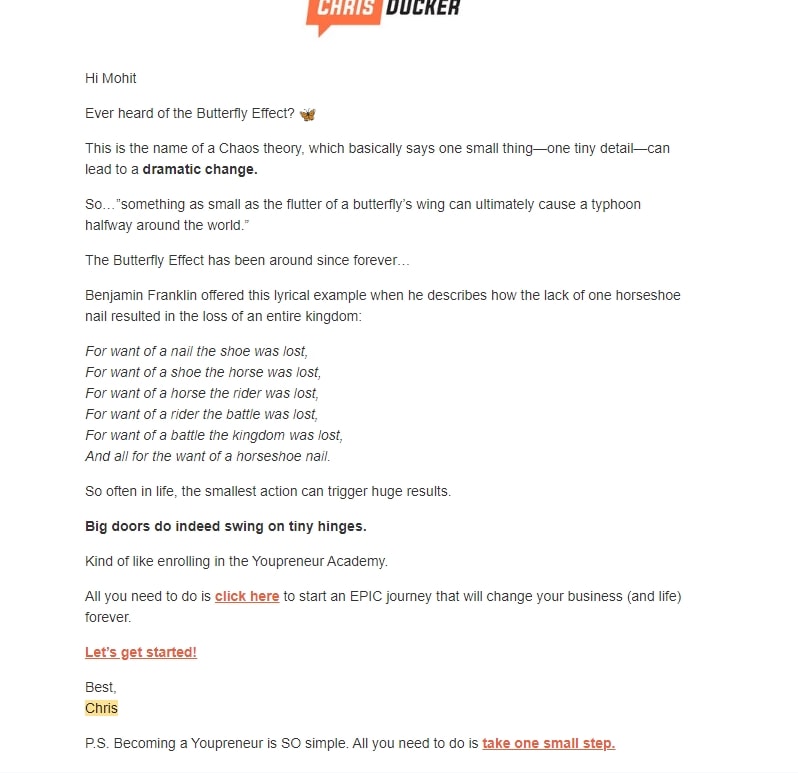
If you read this email, you’ll notice that it only talks about one thing — his course called the Youpreneur Academy. Every email you send should have only one call to action. And this call to action should be clear.
Notice how there are no links other than links to the course’s sales page. For example, in Chris’ email above, you see three links that take you to the same page.
Make sure to add more than one link to the same CTA in your emails. If you can add a big unavoidable button, that’s just the cherry on top!
Only Sending Promotional Emails
If you only use your email list for blasting promotional emails every couple of months, expect to get lots of unsubscribes and very few sales. Unfortunately, this is precisely what most online businesses do.
The worst part about this strategy is that after a while, all your emails will start to land in the Promotions tab or spam.
You need an email funnel to get the most out of email marketing.
An email funnel is a series of emails that delivers value upfront before going for the sale. This is what all successful online businesses do.
Your email funnel doesn’t have to be complex or anything groundbreaking. For example, you could repurpose your best blog content as emails.
This is what an email funnel looks like:
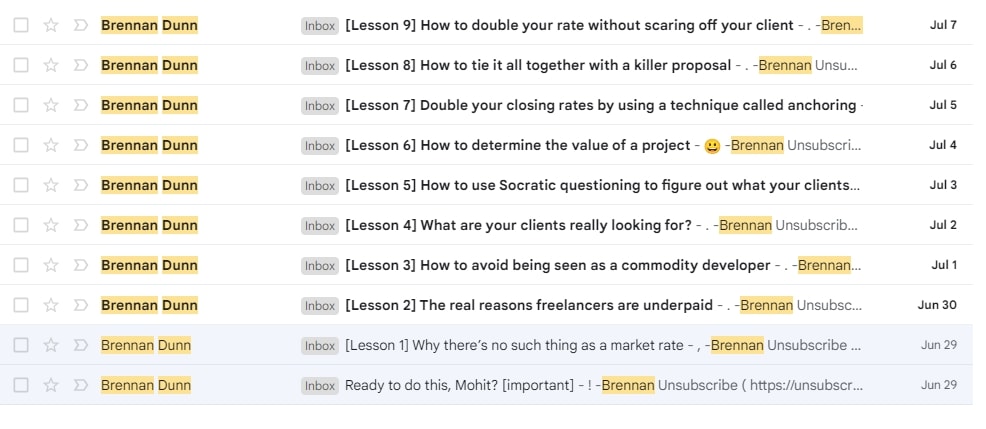
See how none of his emails look like sales emails? That’s because they aren’t!
Brennan’s goal with this series of emails is to overwhelm you with value upfront. This way, when he opens the enrollment to his course, you will already have him in mind as the guy who helped you get more clients and charge higher.
An email funnel’s goal is to slowly guide your subscribers to the sale slowly…
Take a look at the emails Ramit Sethi sent me ahead of the launch of his course:
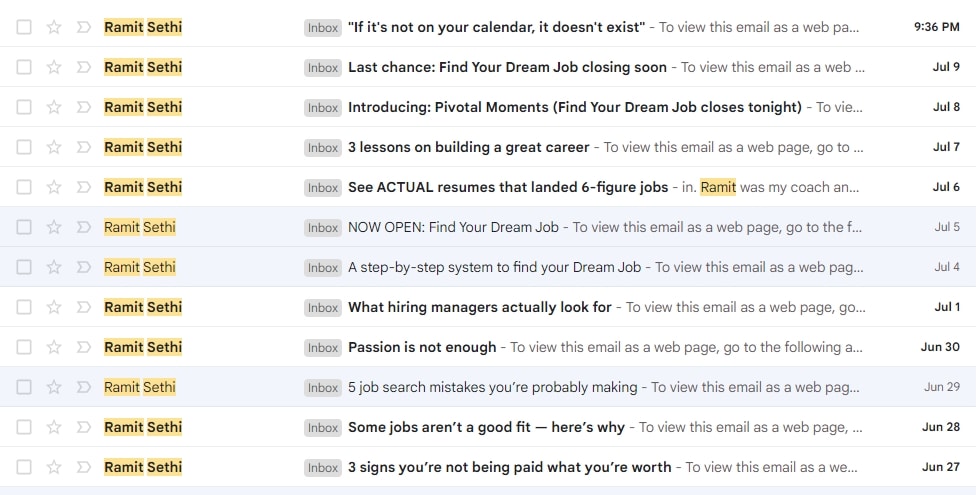
The first couple of emails talk about his new course but don’t actively promote it. He first sends you six emails filled with value before he sends you the email about his new course. He then sends you emails that offer value while promoting his course simultaneously.
To get the most out of email marketing, you must strike a balance between value and sales emails.
Being Too Salesy
Most people will never buy from you if you come off too strong in your emails.
Email Marketing is all about building a relationship with your customers and prospects. If you get too aggressive with your selling, you will lose all your subscribers sooner or later.
We’ve all met that annoying salesman with a cheesy smile who doesn’t leave you alone. You don’t want to be that guy…
There’s a time and place to go for the sale, but if you use the same old sales tactics too often, you’ll turn off your subscribers.
Talking About The Product Rather Than How It Can Help
Your product might be the best in your industry. But if your customers can’t see how it will help them achieve their goals, they won’t buy it.
If you want to make a sale, you need to tell your customers how you can help them become who they want to become or how you can help them achieve their goals. Better yet, show them how you can help.
If you have a case study of how you’ve helped someone before, this is where you can plug it. A case study allows your prospects to imagine themselves achieving the results they want to achieve.
This is exactly what Ramit Sethi did in his latest emails about his course Find Your Dream Job:

Rather than talking about his product, he shares the story of one of his students who got a $10,000 raise and a $5,000 signing bonus using Ramit’s strategies. Imagine being someone who wants to land their dream job and seeing this story in your inbox. Would that interest you to at least check out the product?
Your case studies don’t have to be anything fancy. Just something that shows you know what you’re talking about.
And if you don’t have a case study, talk about why your product differs from everything else on the market. Talk about why and how your product will finally help your subscriber achieve their goals.
Not Segmenting Your Subscribers Based on Their Interests
As much as we marketers hate it, the truth is there are many different segments of customers/prospects in your market, and you need to connect with them with messaging that resonates with them.
One person might want to lose weight because they want to look good before their friend’s wedding, but another might want to lose weight because they are prediabetic and don’t want to let it turn to diabetes.
When you segment your subscribers based on their interests, you have a better chance of hitting the right notes when you promote your products to them.
If you have a personal finance blog, you might find that some customers want to retire early, and others want to save every month until retirement. Both of these demographics require different copies if you’re going to sell to them.
The best example of segmenting I know comes from Ramit Sethi’s blog:
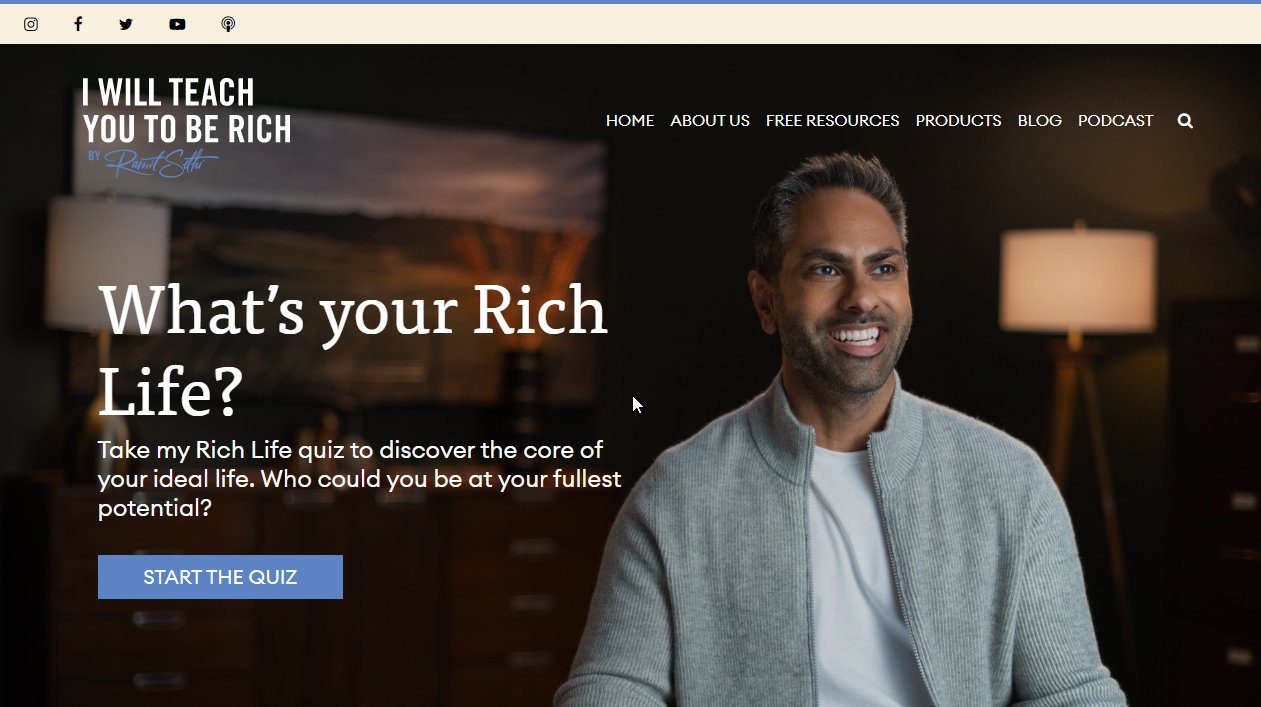
He offers this quiz on the first page of his blog. This quiz aims to ask you a couple of questions that help Ramit tag you in his email marketing platform.
Let’s look at the type of questions he asks you in his quiz:
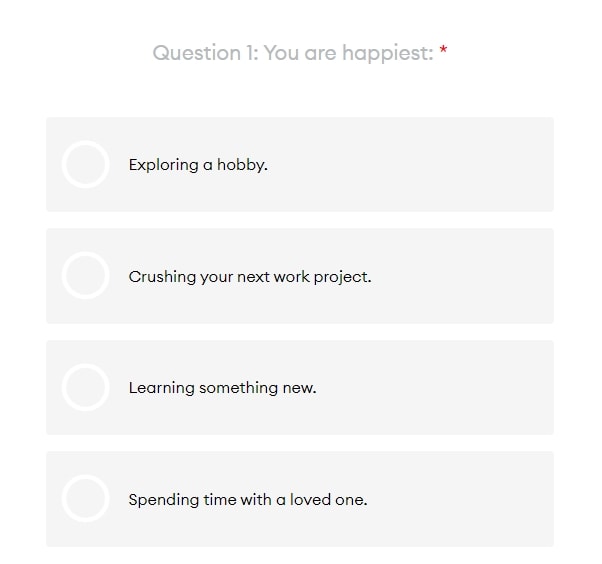
This first question lets Ramit identify what your financial goals are. If you value spending time with family over work, that’s the type of content you will receive.
He asks you many such questions:
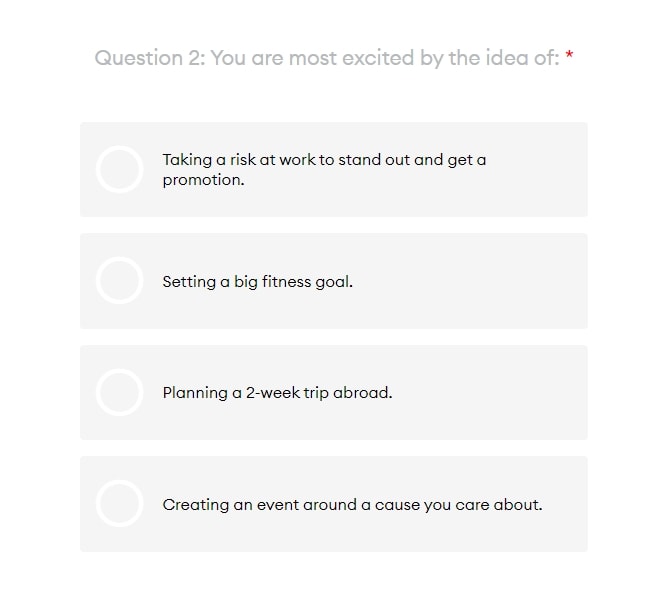
This way, anyone who goes through his quiz segments themselves. Ramit doesn’t have to guess who wants what type of content. He already knows as soon as they sign up.
If you don’t want to segment people when they join your list, you can ask them to qualify themselves in your welcome email.
This is precisely what Chris Ducker does in his welcome email:
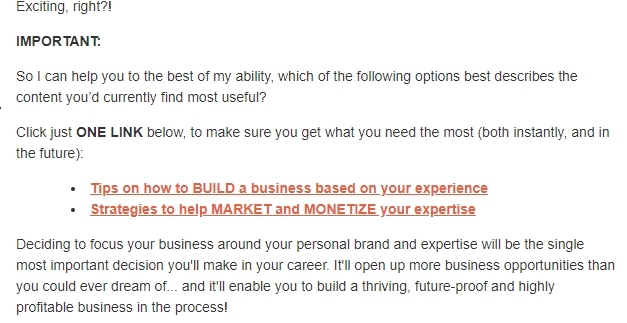
He offers you two links to choose from. Then, you get tagged in his email marketing system based on your chosen link.
Conclusion
If you’re sending a lot of emails without getting any conversions, these tips will help you get on track to turning more of your subscribers into customers.
These tips won’t help you turn your email list into a cash machine overnight, but they will help you build the proper foundation. Businesses that rake in millions of dollars from email marketing have spent years perfecting their email funnels.
Sign up for our email list from the sidebar of our website to receive our best email marketing tips, and save yourself years of trial and error.
